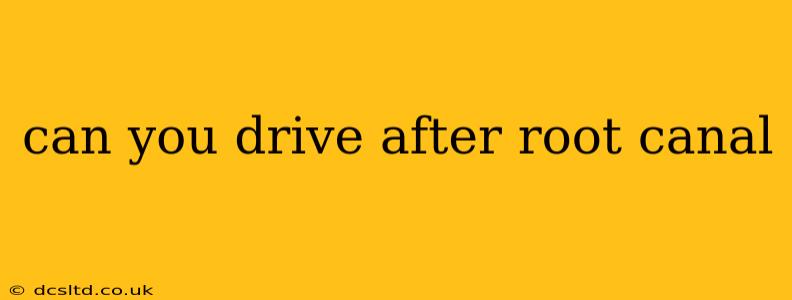Can You Drive After a Root Canal?
The short answer is: yes, you can usually drive after a root canal, but it depends on several factors. While the procedure itself doesn't directly impair driving ability, the effects of the anesthesia and any potential post-procedure discomfort can influence your capacity to safely operate a vehicle. Let's delve into the specifics.
What type of anesthesia is used during a root canal?
Root canals typically involve local anesthesia to numb the area around the affected tooth. This ensures you feel minimal to no pain during the procedure. Sometimes, sedation dentistry might be used, especially for anxious patients, but this is less common for routine root canals. The type of anesthesia used directly impacts your ability to drive afterward.
Can I drive after local anesthesia?
Local anesthesia wears off gradually. While you might feel numb for a few hours after the procedure, you should wait until the numbness fully subsides before driving. Driving with impaired sensation in your mouth or jaw can be dangerous, affecting your ability to control the vehicle or react to unexpected situations. The potential for reduced coordination and reaction time makes driving unsafe until the anesthesia's effects are completely gone.
What about driving after sedation?
If you received sedation dentistry for your root canal, you absolutely should not drive yourself home. Sedation significantly impairs judgment, coordination, and reaction time. You'll need a designated driver to get you home safely. Follow your dentist's post-sedation instructions meticulously.
What if I experience pain or discomfort after the root canal?
Post-root canal discomfort is common, and the level of pain varies from patient to patient. Strong pain relievers prescribed by your dentist could cause drowsiness or dizziness. If you experience these side effects, avoid driving until they subside. It's crucial to prioritize your safety and the safety of others on the road.
How long should I wait before driving after a root canal?
There isn't a universally applicable timeframe. Wait until you feel completely alert, your mouth is fully numb, and any prescribed pain medication has worn off enough to not affect your driving abilities. This could range from a few hours to several hours, depending on the type of anesthesia used and your individual reaction. When in doubt, err on the side of caution and postpone driving.
What are the risks of driving while still under the effects of anesthesia?
Driving under the influence of anesthesia, even local, presents several risks:
- Reduced reaction time: Slowed reflexes can lead to accidents.
- Impaired coordination: Difficulty controlling the vehicle, especially during sudden maneuvers.
- Drowsiness: Falling asleep at the wheel is a significant risk.
- Blurred vision: Reduced visual clarity can make driving extremely hazardous.
Your safety and the safety of others should always be your top priority. Never compromise on your well-being by driving if you're still feeling the effects of anesthesia or experiencing pain and discomfort that could impair your driving ability.
Will my dentist tell me when I can drive?
Your dentist will likely advise you on when you can safely drive after your root canal. Always listen to your dentist's recommendations and follow their instructions carefully. Their advice is tailored to your specific situation and the type of anesthesia used. Don't hesitate to ask questions if you're unsure.
